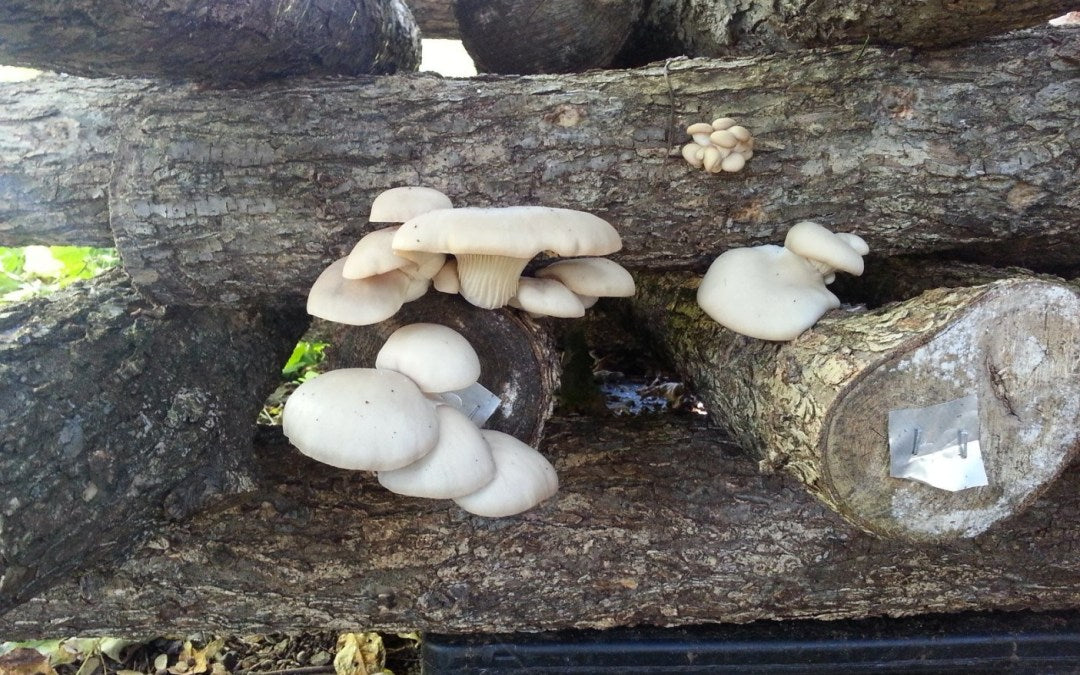There are a variety of mushrooms that grow on trees, so today we are discussing some of the ones you can be growing at home on trees
We have an array of plug spawn for mushrooms that grow on trees. You can use our plug spawn to inoculate logs and stumps around your yard to grow mushrooms for locally-sourced food over many years. Due to the density and size of logs, it may take over 10 years for the mycelium to completely consume the logs, providing many flushes of fresh mushrooms along the way.
Today we are going over recommendations for mushrooms that grow on trees so you can get to inoculating!
Mushrooms that grow on trees: Shiitake
Shiitake mushrooms are native to Japan, Korea, and China. They have been grown on logs for many years and in Japan these mushrooms grow on the shii tree, which is where its name comes from.
The shii tree is related to beech and oak trees, which is most likely a main reason those are preferred tree types for outdoor shiitake cultivation in the United States. Other logs will work but will not produce as high of yields. Learn all about the log inoculation process for growing shiitakes when you take a look at this article.
Mushrooms that grow on trees: Maitake
The scientific name of maitake mushroom is Grifola frondosa. We fi nd these mushrooms growing wild in the Northeast in the late summer and fall.
The maitake is also commonly known as the hen of the woods mushroom. It often grows in clumped, leaf-like shapes at the base of maples and oaks. Maitakes have a semi-firm texture and a complex flavor with notes of earthiness, spiciness, and fruitiness.
Considering the word “maitake” we can break it into two pieces: “mai” meaning dance and “take” meaning mushroom. Some resources have said that this name was purportedly given due to a joyful feeling one gets after eating the maitake mushroom. Perhaps that is the first of the maitake mushroom benefits we should mention: Eating maitakes may lead you to dancing.
Mushrooms that grow on trees: Reishi
Reishi mushroom (Ganoderma tsugae) also grows here in the northeast. You can find it growing on hemlocks, often found near water. The mushrooms will begin forming in the spring and are at maximum potency for a summer harvest, once the mushroom has turned a beautiful red color.
Reishi is an interesting and storied mushroom found in various parts of the world. Reishi has a long history of use in Japan and China and is extremely popular in traditional Chinese medicine (TCM) formulas. Read more about some reishi mushroom benefits here.
Mushrooms that grow on trees: Blue oyster
Blue oysters can be cultivated on straw, wood, coffee grains and a bunch of other cellulose-rich materials. You can use sawdust spawn or plug spawn for inoculating logs for oyster mushroom growing. These mushrooms will be a vibrant blue color when they are young and you will get large fruited bodies. Sawdust spawn is another great option here.
Oyster mushrooms also contain a plethora of valuable constituents, like proteins, amino acids, antioxidants, vitamins and minerals. They are rich in vitamin B and vitamin D. Iron and potassium are also present in these mushrooms.
Mushrooms that grow on trees: Lion’s Mane
Hericium erinaceus, more commonly known as lion’s mane mushroom, is an edible mushroom that grows native throughout North America, Asia, and Europe.
In the wild lion’s mane is often found on hardwoods like American beech trees. The lion’s mane mushroom has long white spines that give it the appearance of a beard or mane (lion’s mane has also been referred to as bearded tooth mushroom, bearded hedgehog mushroom, and satyr’s beard).
Mushrooms that grow on trees: Chicken of the woods
Chicken of the woods is also known as the sulphur shelf mushroom, referring to its bright orange and yellow or white pores. It’s a very bright, vibrant mushroom you can find while foraging in the forest. It’s scientific name is Laetiporus sulphureus or Laetiporus cincinnatus. The mushroom is called the chicken of the woods because its texture is said to resemble the texture of cooked chicken.
Chicken of the woods are most commonly foraged in the wild. They are frequently found growing from wounds of oak trees or at the base of the tree. The mushroom can also be found on some types of conifers, sweet chestnut trees or willow trees. In the Northeast, these mushrooms appear from early spring to late autumn.
Use sawdust spawn and plug spawn for your own log growing
We have spawn for each species of mushroom listed above, so you can start growing your own gourmet mushrooms at home.
Take a look at both our sawdust spawn page and our plug spawn page. Sawdust spawn will colonize a log quicker than plug spawn, but the process of inoculation can go quicker with the use of plugs.
What types of mushrooms have you seen growing on trees in the wild?
-------
Content & Optimization by Chris Sturk

